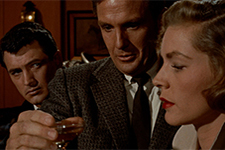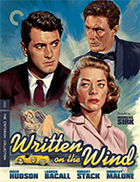Written on the Wind
|  Written on the Wind is by far the most sordid of director Douglas Sirk’s 1950s social dramas. The debauched tale of an uberwealthy, but deeply troubled Texas oil family, it reaches near hysterical melodramatic proportions, dealing as it does with alcoholism, nymphomania, sterility, adultery, and murder. Audiences at the time ate it up as a lurid, but straightforward soap opera of familial dysfunction on a grand scale; but, since the early 1970s, critics and scholars have come to understand it as purposeful self-parody, a way in which Sirk could critique American social conventions and the capitalist drive while still appearing to play within the rules of the Hollywood studio system. Sirk’s other ’50s melodramas for Universal-International, including Magnificent Obsession (1954) and All That Heaven Allows (1955), were set within the middle and upper middle classes, which put characters on-screen that many in the audience could recognize and relate to.Written on the Wind is different in that it deals with multi-millionaires at the highest echelons of the socioeconomic ladder, which creates an immediate distancing effect: Watching the characters on screen becomes inherently voyeuristic in nature, as it is almost impossible for most of us to identify directly with them and their money-saturated personal woes. In terms of social commentary, the film is probably best seen as a parody of the ultimate realization of the American dream. The Hadley family in Written on the Wind has achieved everything possible in terms of capitalistic gain, yet they are fundamentally miserable. The film was adapted by George Zuckerman from Robert Wilder’s popular 1946 novel, which was immediately recognized by critics as purposefully scandalous and lurid: “Wilder may not have concerned himself overmuch with art,” wrote Orville Prescott in his New York Times review, “but he certainly knew what he was doing.” Prescott, noting that the novel had already drawn Hollywood’s attention, mused at the end of his review about “what a job some screen writer will have fixing up a scenario that will get by the Hays-Johnston office [aka, the Production Code Administration]!” Of course, screenwriters like Zuckerman (who also wrote Sirk’s next film, The Tarnished Angels) were well versed in how to pack as much indecent material as possible into a film while still staying true to the letter of the Code, and Written on the Wind is a fantastic case study of how much can be suggested with imagery, dialogue, and glances while avoiding the explicitness of the novel. The story deals primarily with the interactions among four main characters. Kyle Hadley (Robert Stack), the heir to the Hadley Oil Company empire, is an alcoholic, self-pitying playboy who is incapable of responsibility. Mitch Wayne (Rock Hudson), his best friend and adopted brother of sorts, is his down-to-earth opposite; level-headed and honest, he has a degree in geology from the university from which Kyle was expelled, which makes him the most obvious choice to take over the business. Kyle’s sister, Marylee (Dorothy Malone), is as troubled as he is, but she embodies her emotional dysfunction through nymphomania and wicked, spiteful manipulation of those around her. She goes beyond simply “loose” sexuality; as one male character says, “I’ve never heard of anyone picking her up. It’s always the other way around.” Finally, there is Lucy Moore (Lauren Bacall), a secretary whom Kyle romances and quickly marries, then destroys out of jealousy and misunderstanding. This quartet of characters is easily divided down the middle, with Kyle and Marylee on the “dysfunctional” side and Mitch and Lucy on the “normal” side. Yet, their lives are deeply intertwined beyond just blood relations and marriage vows. Marylee has been infatuated with Mitch since they were children, and her excessive sexuality may be in some way compensation for the fact that he could never love her back as anything more than “a sister.” At the same time, Mitch is in love with Lucy, but his essentially decent nature keeps him from advancing on her because she is Kyle’s wife. Some have seen Written on the Wind as a precursor to the ’80s prime-time soap opera Dallas, with its emphasis on debauched wealthy characters and its setting in the Texas oil business (changed from the novel’s North Carolina tobacco empire, which was modeled on the R.J. Reynolds Tobacco company and the 1932 scandal in which the company’s youngest heir was either murdered or committed suicide at the family estate, which parallels the novel’s precipitating event). Others view it as pure camp, an exercise in outrageous kitsch that is all the more amusing when you imagine that viewers took it seriously when it first played in theaters. It can also sustain a deeply Freudian reading, as sexuality, the threat of sterility, and failed patriarchy drive much of the narrative. It has all the right ingredients, with the powerless patriarch, Jasper Hadley (Robert Keith), overrun by his out-of-control offspring, who fully embody the kinds of traits (excessive consumption, flamboyant sexuality) that American society traditionally has tried to repress. Kyle and, especially, Marylee are literally “the return of the repressed,” which is embodied in a hilariously overdetermined scene in which Marylee, recently picked up by the police after a liaison with a gas station attendant at the local motel, breaks into a wild dance in her bedroom upstairs, which is intercut with Jasper’s making his way up the staircase and then having a heart attack and plummeting to the bottom. The visual connection between Marylee’s sexual display and her father’s pathetic death tumble make the obvious suggestion that her irrepressibility literally killed him. Jasper is the most tragic character in the film simply because we know next to nothing about him except that he has been an utter failure as a father. And, while the end of the film suggests a tragic understanding of Marylee, which conflicts with her frequently cruel and manipulative behavior (this is not surprising because Sirk loved to work with character ambiguity). Malone won a Best Supporting Actress Oscar for the role, and while parts of her performance are decidedly overwrought, there is a genuine sense of melancholy beneath the hysteria, and she succeeds in generating empathy because we recognize how much of Marylee’s acting out comes from a place of deep pain and sadness and rejection. Heavily symbolic moments are scattered throughout Written on the Wind to great effect. One memorable scene shows Kyle stumbling out of a drugstore after meeting with the local doctor and finding out that he may be sterile, which strips him of his selfhood by denying him the ability to reproduce, leading to a downward spiral that eventually culminates in murder. Sirk overloads the frame with symbols that, along with the swelling music, magnify Kyle’s distraught emotions to ludicrous heights. First, he walks past dozens of signs proclaiming “Buy Quality Drugs Here,” reminding us that Kyle’s sexuality is unfit and must be aided by modern medicine. Then, in the coup de grace, outside the store he sees a little boy gleefully bouncing up and down on a mechanical horse, bringing to mind both childhood and sexual activity, two things that, for Kyle, are forever destroyed. It is one of the most gloriously overdetermined moments in Sirk’s entire oeuvre. Sirk also employs architecture to convey emotional states, especially his use of the Hadley family estate. Although large and beautiful, it is also cold and empty, with cavernous open spaces and marble floors and walls that don’t invite feelings of familial love and togetherness, but rather of isolation and despair. He also conveys an implicit critique of the Hadley Oil Company’s having taken over the small town of Hadley, Texas (named, we assume, for the family, not the other way around) by constantly including its corporate logo everywhere, from the sides of buildings, to car doors, to billboards. The opening shots of the film show how the Hadley Oil Company dominates the town visually, with endless rows of phallic oil towers and the enormous corporate skyscraper that is three times taller than any other building. The Hadleys are everywhere, yet emotionally and spiritually they are nowhere. In a study of Dostoyevsky and Gogol, Yuri Tynyanov wrote, “When stylization is strongly marked, it becomes parody.” As Paul Willemen pointed out in his widely influential 1971 article “Distanciation and Douglas Sirk” (an early attempt to recuperate Sirk’s career), this is particularly applicable to many of Sirk’s films, especially Written on the Wind. From its overuse of cliches, to its overwrought baroque color scheme, to its hysterical narrative and exploitation of uncomfortable subject matter, it is a twisted masterpiece of self-parody. Although not for every taste,Written on the Wind forces a response, whether that be pouring tears or outright laughter. It is a film that cannot be ignored.
Copyright © 2022 James Kendrick Thoughts? E-mail James Kendrick All images copyright © The Criterion Collection | |||||||||||||||||||||||||||||
Overall Rating: 


 (3.5)
(3.5)


